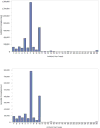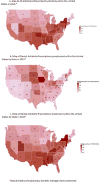An evaluation of dental antibiotic prescribing practices in the United States
- PMID: 28941554
- PMCID: PMC5705569
- DOI: 10.1016/j.adaj.2017.07.019
An evaluation of dental antibiotic prescribing practices in the United States
Abstract
Background: Antibiotic prescribing practices among general dentists and dental specialists in the United States remains poorly understood. The purpose of this study was to compare prescribing practices across dental specialties, evaluate the duration of antibiotics dentists prescribed, and determine variation in antibiotic selection among dentists.
Methods: The authors performed a retrospective cross-sectional analysis of dental care provider specialties linked to deidentified antibiotic claims data from a large pharmacy benefits manager during the 2015 calendar year.
Results: As a group, general dentists and dental specialists were responsible for more than 2.9 million antibiotic prescriptions, higher than levels for several other medical and allied health care provider specialties. Antibiotic treatment duration generally was prolonged and commonly included broad-spectrum agents, such as amoxicillin clavulanate and clindamycin. Although amoxicillin was the most commonly prescribed antibiotic among all dental specialties, there was substantial variation among other antibiotics each specialty selected. The most common antibiotic treatment durations were 7 and 10 days.
Conclusions: This study's results demonstrate that dentists frequently prescribe antibiotics for prolonged periods and often use broad-spectrum antibiotics. Further studies are necessary to evaluate the appropriateness of these antibiotic prescribing patterns.
Practical implications: The clinically significant variation in antibiotic selection and treatment duration identified among all dental specialties in this study population implies that further research and guidance into the treatment of dental infections is necessary to improve and standardize antibiotic prescribing practices.
Keywords: Antibiotics; dentistry; prophylaxis; treatment.
Copyright © 2017 American Dental Association. Published by Elsevier Inc. All rights reserved.
References
-
- [Accessed May 15, 2017];Antibiotic Resistance Threats in the United States. 2013 Available at: http://www.cdc.gov/drugresistance/pdf/ar-threats-2013-508.pdf.
-
- Suda KJ, Hicks LA, Roberts RM, Hunkler RJ, Danziger LH. A national evaluation of antibiotic expenditures by healthcare setting in the United States, 2009. J Antimicrob Chemother. 2013;68(3):715–8. - PubMed
-
- Fleming-Dutra KE, Hersh AL, Shapiro DJ, et al. Prevalence of Inappropriate Antibiotic Prescriptions Among US Ambulatory Care Visits, 2010–2011. JAMA. 2016;315(17):1864–73. - PubMed
-
- CDC Newsroom Release. [Accessed May 15, 2017];CDC: 1 in 3 antibiotic prescriptions unnecessary. Available at: https://www.cdc.gov/media/releases/2016/p0503-unnecessary-prescriptions.....
-
- [Accessed July 10, 2017];CDC Get Smart About Antibiotics. Available at: https://www.cdc.gov/getsmart/index.html.
Publication types
MeSH terms
Substances
Grants and funding
LinkOut - more resources
Full Text Sources
Other Literature Sources
Medical
Research Materials




